文章目录
- 解析全局配置文件
- 二级缓存解析
- 解析二级缓存
- 缓存中的调用过程
- 缓存中使用的设计模式
- 解析SQL
解析全局配置文件
启动流程分析
String resource = "mybatis-config.xml";
//将XML配置文件构建为Configuration配置类
reader = Resources.getResourceAsReader(resource);
// 通过加载配置文件流构建一个SqlSessionFactory DefaultSqlSessionFactory
SqlSessionFactory sqlMapper = new SqlSessionFactoryBuilder().build(reader);
通过上面代码发现,创建SqlSessionFactory的代码在SqlSessionFactoryBuilder中,进去一探究竟:
//整个过程就是将配置文件解析成Configration对象,然后创建SqlSessionFactory的过程
//Configuration是SqlSessionFactory的一个内部属性
public SqlSessionFactory build(Reader reader, String environment, Properties properties) {try {XMLConfigBuilder parser = new XMLConfigBuilder(reader, environment, properties);return build(parser.parse());} catch (Exception e) {throw ExceptionFactory.wrapException("Error building SqlSession.", e);} finally {ErrorContext.instance().reset();try {if (reader != null) {reader.close();}} catch (IOException e) {// Intentionally ignore. Prefer previous error.}}}
下面是解析配置文件的核心方法:
public Configuration parse() {//若已经解析过了 就抛出异常if (parsed) {throw new BuilderException("Each XMLConfigBuilder can only be used once.");}parsed = true;/*** 解析我们的mybatis-config.xml的* 节点* <configuration>* </configuration>*/parseConfiguration(parser.evalNode("/configuration"));return configuration;}/*** 解析我们mybatis-config.xml的 configuration节点* @param root*/private void parseConfiguration(XNode root) {try {// issue #117 read properties first/*** 解析 properties节点* <properties resource="db.properties" />* 解析到org.apache.ibatis.parsing.XPathParser#variables* org.apache.ibatis.session.Configuration#variables*/propertiesElement(root.evalNode("properties"));/*** 解析我们的mybatis-config.xml中的settings节点* 具体可以配置哪些属性:http://www.mybatis.org/mybatis-3/zh/configuration.html#settings* <settings><setting name="cacheEnabled" value="true"/><setting name="lazyLoadingEnabled" value="true"/><setting name="mapUnderscoreToCamelCase" value="false"/><setting name="localCacheScope" value="SESSION"/><setting name="jdbcTypeForNull" value="OTHER"/>..............</settings>**/Properties settings = settingsAsProperties(root.evalNode("settings"));/*** 基本没有用过该属性* VFS含义是虚拟文件系统;主要是通过程序能够方便读取本地文件系统、FTP文件系统等系统中的文件资源。Mybatis中提供了VFS这个配置,主要是通过该配置可以加载自定义的虚拟文件系统应用程序解析到:org.apache.ibatis.session.Configuration#vfsImpl*/loadCustomVfsImpl(settings);/*** 指定 MyBatis 所用日志的具体实现,未指定时将自动查找。* SLF4J | LOG4J | LOG4J2 | JDK_LOGGING | COMMONS_LOGGING | STDOUT_LOGGING | NO_LOGGING* 解析到org.apache.ibatis.session.Configuration#logImpl*/loadCustomLogImpl(settings);/*** 解析我们的别名* <typeAliases><typeAlias alias="User" type="com.mcode.entity.User"/></typeAliases><typeAliases><package name="com.mcode.entity"/></typeAliases>解析到oorg.apache.ibatis.session.Configuration#typeAliasRegistry.typeAliases除了自定义的,还有内置的*/typeAliasesElement(root.evalNode("typeAliases"));/*** 解析我们的插件(比如分页插件)* mybatis自带的* Executor (update, query, flushStatements, commit, rollback, getTransaction, close, isClosed)ParameterHandler (getParameterObject, setParameters)ResultSetHandler (handleResultSets, handleOutputParameters)StatementHandler (prepare, parameterize, batch, update, query)解析到:org.apache.ibatis.session.Configuration#interceptorChain.interceptors*/pluginsElement(root.evalNode("plugins"));/*** 可以配置 一般不会去设置* 对象工厂 用于反射实例化对象、对象包装工厂、* 反射工厂 用于属性和setter/getter 获取*/objectFactoryElement(root.evalNode("objectFactory"));objectWrapperFactoryElement(root.evalNode("objectWrapperFactory"));reflectorFactoryElement(root.evalNode("reflectorFactory"));// 设置settings 和默认值到configurationsettingsElement(settings);/*** 解析我们的mybatis环境<environments default="dev"><environment id="dev"><transactionManager type="JDBC"/><dataSource type="POOLED"><property name="driver" value="${jdbc.driver}"/><property name="url" value="${jdbc.url}"/><property name="username" value="root"/><property name="password" value="Zw726515"/></dataSource></environment></environments>* 解析到:org.apache.ibatis.session.Configuration#environment* 在集成spring情况下由 spring-mybatis提供数据源 和事务工厂*/environmentsElement(root.evalNode("environments"));/*** 解析数据库厂商* <databaseIdProvider type="DB_VENDOR"><property name="SQL Server" value="sqlserver"/><property name="DB2" value="db2"/><property name="Oracle" value="oracle" /><property name="MySql" value="mysql" /></databaseIdProvider>* 解析到:org.apache.ibatis.session.Configuration#databaseId*/databaseIdProviderElement(root.evalNode("databaseIdProvider"));/*** 解析我们的类型处理器节点* <typeHandlers><typeHandler handler="org.mybatis.example.ExampleTypeHandler"/></typeHandlers>解析到:org.apache.ibatis.session.Configuration#typeHandlerRegistry.typeHandlerMap*/typeHandlersElement(root.evalNode("typeHandlers"));/*** 解析我们的mapper*resource:来注册我们的class类路径下的url:来指定我们磁盘下的或者网络资源的class:若注册Mapper不带xml文件的,这里可以直接注册若注册的Mapper带xml文件的,需要把xml文件和mapper文件同名 同路径--><mappers><mapper resource="mybatis/mapper/EmployeeMapper.xml"/><mapper class="com.mcode.mapper.EmployeeMapper"></mapper><package name="com.mcode.mapper"></package>--></mappers>* package* ·解析mapper接口代理工厂(传入需要代理的接口) 解析到:org.apache.ibatis.session.Configuration#mapperRegistry.knownMappers·解析mapper.xml 最终解析成MappedStatement 到:org.apache.ibatis.session.Configuration#mappedStatements*/mappersElement(root.evalNode("mappers"));} catch (Exception e) {throw new BuilderException("Error parsing SQL Mapper Configuration. Cause: " + e, e);}}
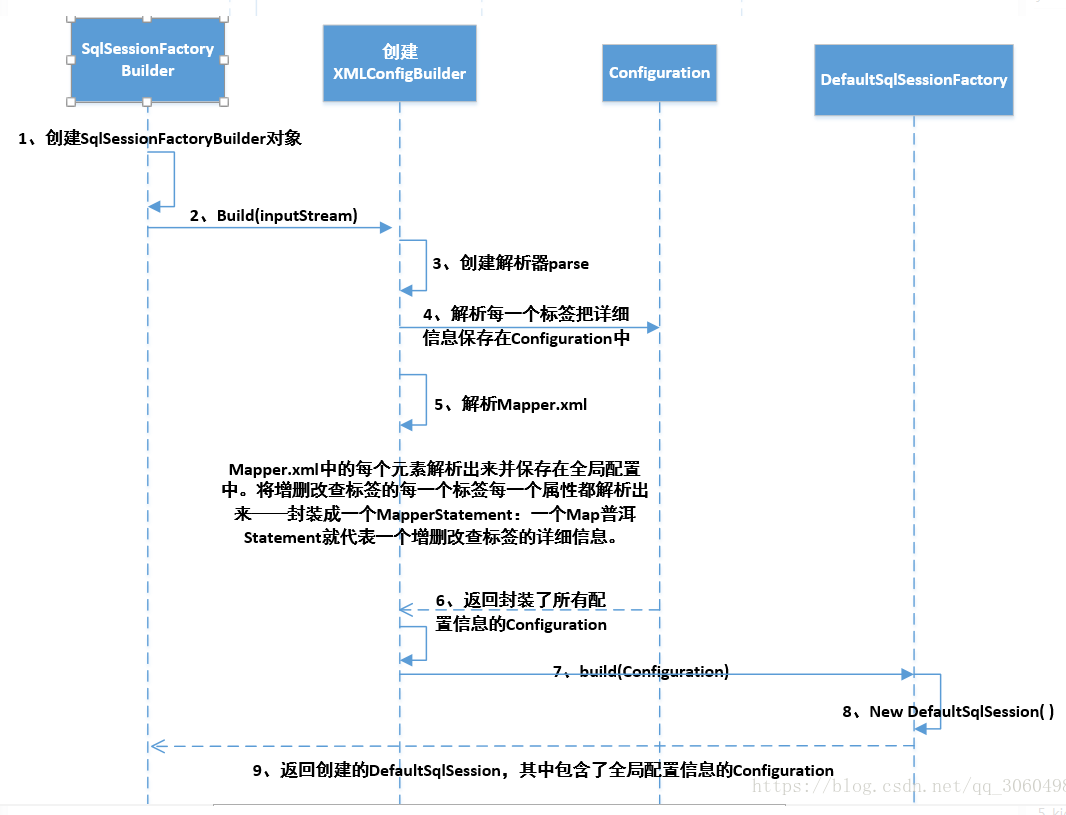
上面解析流程结束后会生成一个Configration对象,包含所有配置信息,然后会创建一个SqlSessionFactory对象,这个对象包含了Configration对象。
简单总结
对于MyBatis启动的流程(获取SqlSession的过程)这边简单总结下:
- SqlSessionFactoryBuilder解析配置文件,包括属性配置、别名配置、拦截器配置、环境(数据源和事务管理器)、Mapper配置等;解析完这些配置后会生成一个Configration对象,这个对象中包含了MyBatis需要的所有配置,然后会用这个Configration对象创建一个SqlSessionFactory对象,这个对象中包含了Configration对象;
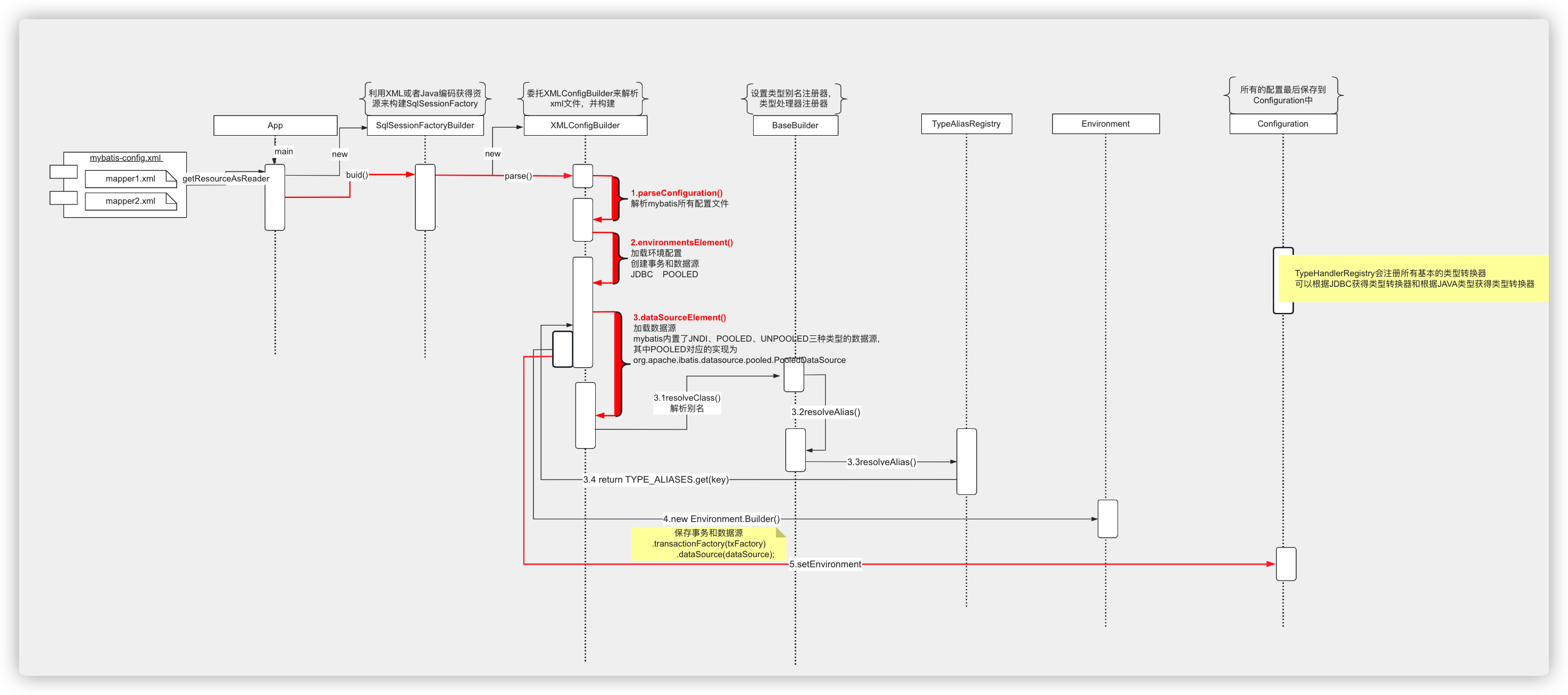
二级缓存解析
解析二级缓存
解析mapper文件
private void mappersElement(XNode context) throws Exception {if (context == null) {return;}/*** 获取我们mappers节点下的一个一个的mapper节点*/for (XNode child : context.getChildren()) {/*** 判断我们mapper是不是通过批量注册的* <package name="com.mcode.mapper"></package>*/if ("package".equals(child.getName())) {String mapperPackage = child.getStringAttribute("name");configuration.addMappers(mapperPackage);} else {/*** 判断从classpath下读取我们的mapper* <mapper resource="mybatis/mapper/EmployeeMapper.xml"/>*/String resource = child.getStringAttribute("resource");/*** 判断是不是从我们的网络资源读取(或者本地磁盘得)* <mapper url="D:/mapper/EmployeeMapper.xml"/>*/String url = child.getStringAttribute("url");/*** 解析这种类型(要求接口和xml在同一个包下)* <mapper class="com.mcode.mapper.DeptMapper"></mapper>**/String mapperClass = child.getStringAttribute("class");/*** 我们得mappers节点只配置了* <mapper resource="mybatis/mapper/EmployeeMapper.xml"/>*/if (resource != null && url == null && mapperClass == null) {ErrorContext.instance().resource(resource);/*** 把我们的文件读取出一个流*/try (InputStream inputStream = Resources.getResourceAsStream(resource)) {/*** 创建读取XmlMapper构建器对象,用于来解析我们的mapper.xml文件*/XMLMapperBuilder mapperParser = new XMLMapperBuilder(inputStream, configuration, resource,configuration.getSqlFragments());/*** 真正的解析我们的mapper.xml配置文件(说白了就是来解析我们的sql)*/mapperParser.parse();}} else if (resource == null && url != null && mapperClass == null) { ErrorContext.instance().resource(url);try (InputStream inputStream = Resources.getUrlAsStream(url)) {XMLMapperBuilder mapperParser = new XMLMapperBuilder(inputStream, configuration, url,configuration.getSqlFragments());mapperParser.parse();}} else if (resource == null && url == null && mapperClass != null) {Class<?> mapperInterface = Resources.classForName(mapperClass);configuration.addMapper(mapperInterface);} else {throw new BuilderException("A mapper element may only specify a url, resource or class, but not more than one.");}}}}解析mapper
/*** 真正的去解析我们的Mapper.xml(EmployeeMapper.xml)*/public void parse() {/*** 判断当前的Mapper是否被加载过*/if (!configuration.isResourceLoaded(resource)) {/*** 真正的解析我们的 <mapper namespace="com.mcode.mapper.EmployeeMapper">**/configurationElement(parser.evalNode("/mapper"));/*** 把资源保存到我们Configuration中*/configuration.addLoadedResource(resource);bindMapperForNamespace();}parsePendingResultMaps();parsePendingCacheRefs();parsePendingStatements();}public XNode getSqlFragment(String refid) {return sqlFragments.get(refid);}/*** 解析我们的<mapper></mapper>节点* @param context*/private void configurationElement(XNode context) {try {/*** 解析我们的namespace属性* <mapper namespace="com.cmode.mapper.EmployeeMapper">*/String namespace = context.getStringAttribute("namespace");if (namespace == null || namespace.isEmpty()) {throw new BuilderException("Mapper's namespace cannot be empty");}/*** 保存我们当前的namespace 并且判断接口完全类名==namespace*/builderAssistant.setCurrentNamespace(namespace);/*** 解析我们的缓存引用* 说明我当前的缓存引用和DeptMapper的缓存引用一致* <cache-ref namespace="com.tuling.mapper.DeptMapper"></cache-ref>解析到org.apache.ibatis.session.Configuration#cacheRefMap<当前namespace,ref-namespace>异常下(引用缓存未使用缓存):org.apache.ibatis.session.Configuration#incompleteCacheRefs*/cacheRefElement(context.evalNode("cache-ref"));/*** 解析我们的cache节点* <cache ></cache>解析到:org.apache.ibatis.session.Configuration#cachesorg.apache.ibatis.builder.MapperBuilderAssistant#currentCache*/cacheElement(context.evalNode("cache"));/*** 解析paramterMap节点(该节点mybaits3.5貌似不推荐使用了)*/parameterMapElement(context.evalNodes("/mapper/parameterMap"));/*** 解析我们的resultMap节点* 解析到:org.apache.ibatis.session.Configuration#resultMaps* 异常 org.apache.ibatis.session.Configuration#incompleteResultMaps**/resultMapElements(context.evalNodes("/mapper/resultMap"));/*** 解析我们通过sql片段* 解析到org.apache.ibatis.builder.xml.XMLMapperBuilder#sqlFragments* 其实等于 org.apache.ibatis.session.Configuration#sqlFragments* 因为他们是同一引用,在构建XMLMapperBuilder 时把Configuration.getSqlFragments传进去了*/sqlElement(context.evalNodes("/mapper/sql"));/*** 解析我们的select | insert |update |delete节点* 解析到org.apache.ibatis.session.Configuration#mappedStatements*/buildStatementFromContext(context.evalNodes("select|insert|update|delete"));} catch (Exception e) {throw new BuilderException("Error parsing Mapper XML. The XML location is '" + resource + "'. Cause: " + e, e);}}
解析Cache
/*** 解析cache* @param context*/private void cacheElement(XNode context) {if (context != null) {//解析cache节点的type属性String type = context.getStringAttribute("type", "PERPETUAL");// 根据别名(或完整限定名) 加载为ClassClass<? extends Cache> typeClass = typeAliasRegistry.resolveAlias(type);/*获取缓存过期策略:默认是LRULRU – 最近最少使用:移除最长时间不被使用的对象。(默认)FIFO – 先进先出:按对象进入缓存的顺序来移除它们。SOFT – 软引用:基于垃圾回收器状态和软引用规则移除对象。WEAK – 弱引用:更积极地基于垃圾收集器状态和弱引用规则移除对象。*/String eviction = context.getStringAttribute("eviction", "LRU");Class<? extends Cache> evictionClass = typeAliasRegistry.resolveAlias(eviction);//flushInterval(刷新间隔)属性可以被设置为任意的正整数,设置的值应该是一个以毫秒为单位的合理时间量。 默认情况是不设置,也就是没有刷新间隔,缓存仅仅会在调用语句时刷新。Long flushInterval = context.getLongAttribute("flushInterval");//size(引用数目)属性可以被设置为任意正整数,要注意欲缓存对象的大小和运行环境中可用的内存资源。默认值是 1024。Integer size = context.getIntAttribute("size");//只读)属性可以被设置为 true 或 false。只读的缓存会给所有调用者返回缓存对象的相同实例。 因此这些对象不能被修改。这就提供了可观的性能提升。而可读写的缓存会(通过序列化)返回缓存对象的拷贝。 速度上会慢一些,但是更安全,因此默认值是 falseboolean readWrite = !context.getBooleanAttribute("readOnly", false);boolean blocking = context.getBooleanAttribute("blocking", false);Properties props = context.getChildrenAsProperties();//把缓存节点加入到Configuration中builderAssistant.useNewCache(typeClass, evictionClass, flushInterval, size, readWrite, blocking, props);}}
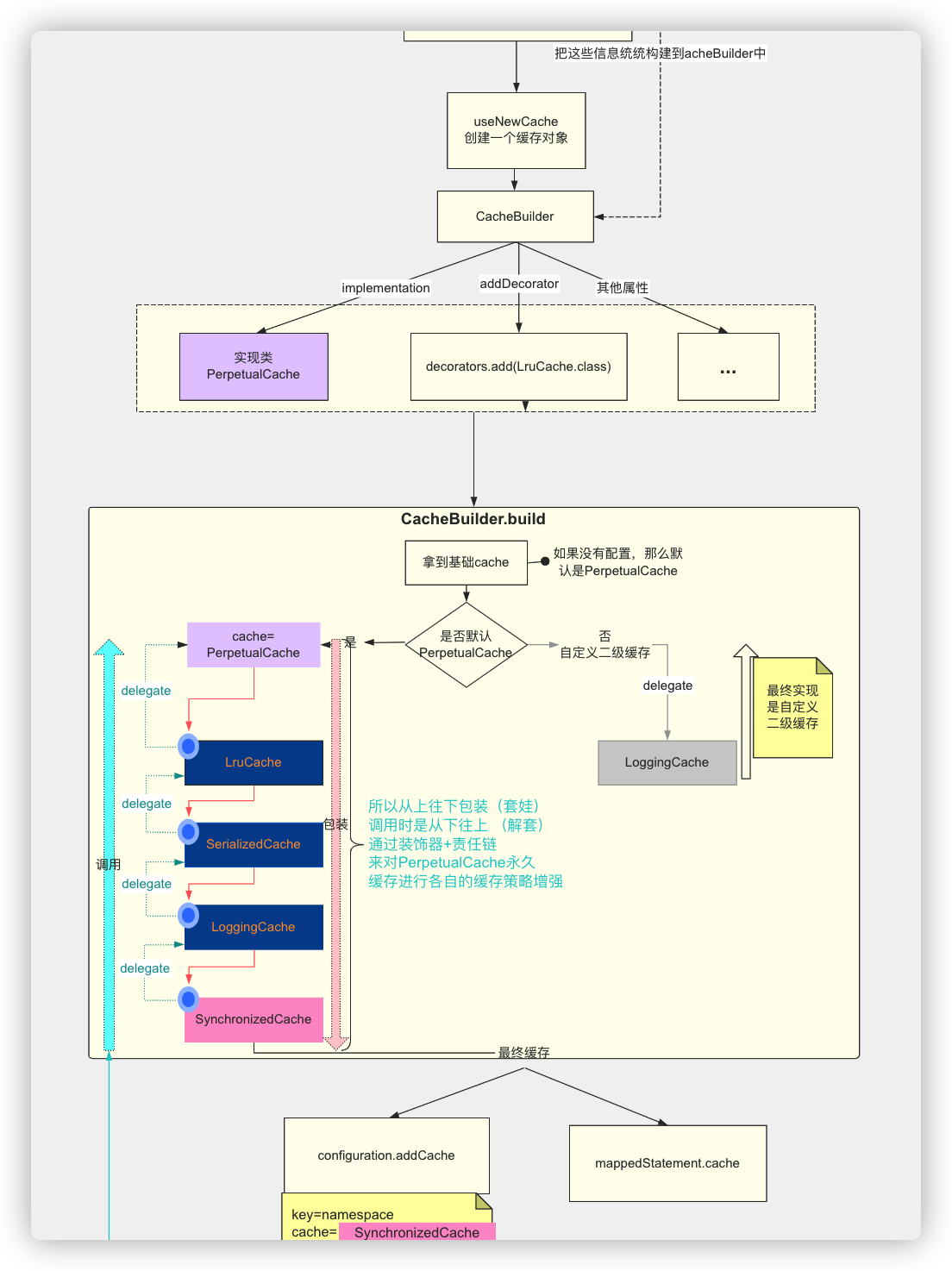
缓存中的调用过程
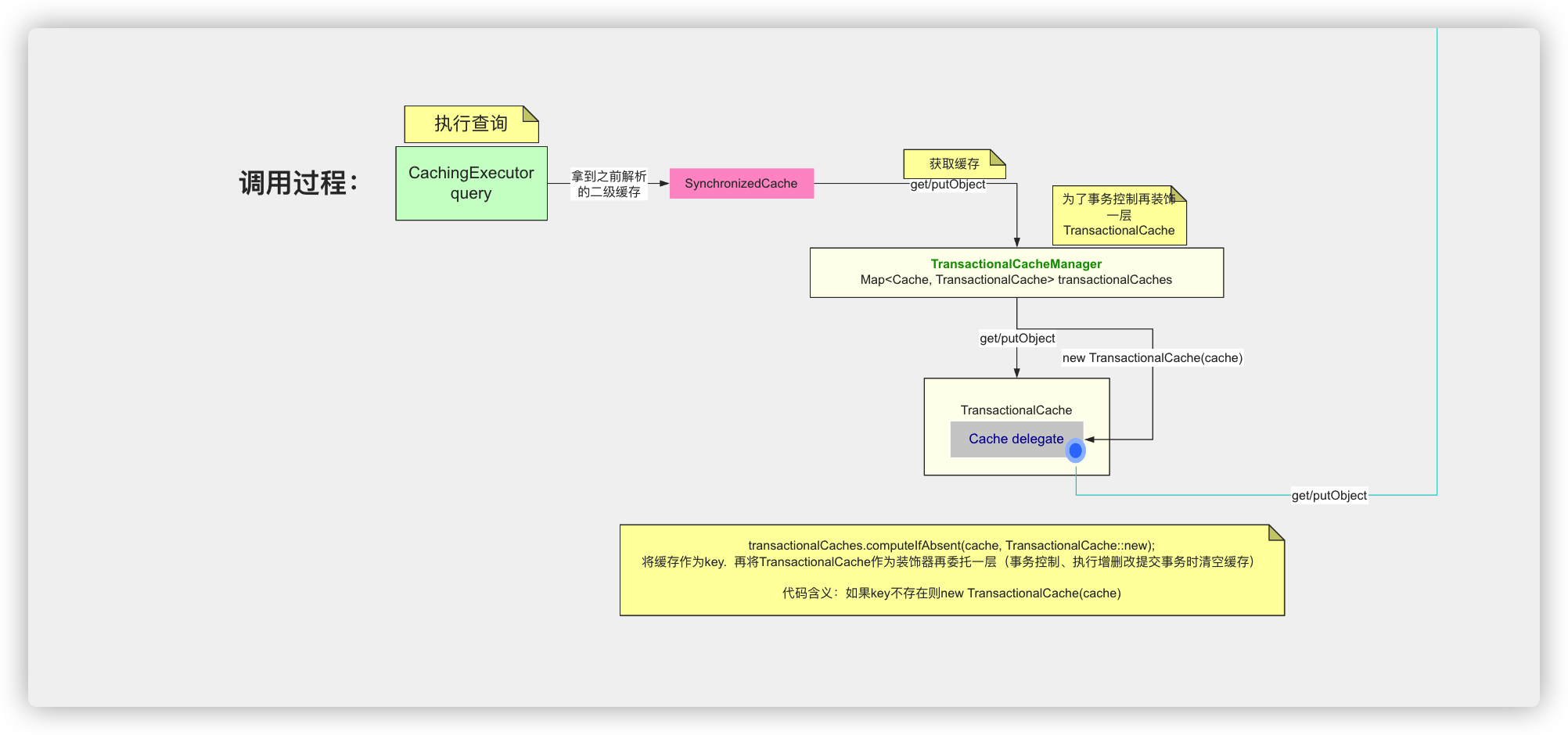
缓存中使用的设计模式
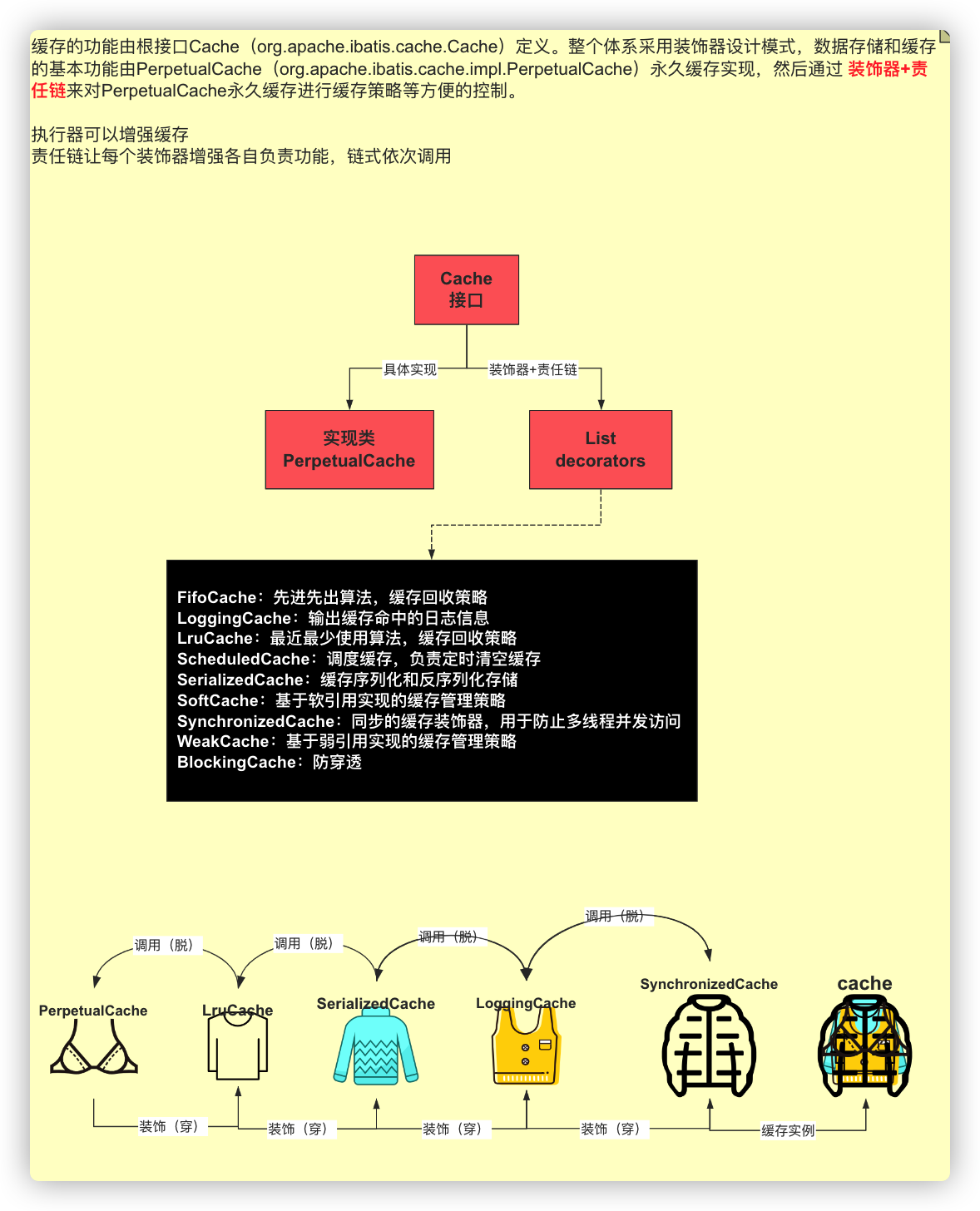
解析SQL
buildStatementFromContext
/*** 方法实现说明:解析我们得得select|update|delte|insert节点然后* 创建我们得mapperStatment对象* @param list:所有的select|update|delte|insert节点* @param requiredDatabaseId:判断有没有数据库厂商Id*/private void buildStatementFromContext(List<XNode> list, String requiredDatabaseId) {/*** 循环我们的select|delte|insert|update节点*/for (XNode context : list) {/*** 创建一个xmlStatement的构建器对象*/final XMLStatementBuilder statementParser = new XMLStatementBuilder(configuration, builderAssistant, context, requiredDatabaseId);try {statementParser.parseStatementNode();} catch (IncompleteElementException e) {configuration.addIncompleteStatement(statementParser);}}}
parseStatementNode
public void parseStatementNode() {/*** 我们的insert|delte|update|select 语句的sqlId*/String id = context.getStringAttribute("id");/*** 判断我们的insert|delte|update|select 节点是否配置了* 数据库厂商标注*/String databaseId = context.getStringAttribute("databaseId");/*** 匹配当前的数据库厂商id是否匹配当前数据源的厂商id*/if (!databaseIdMatchesCurrent(id, databaseId, this.requiredDatabaseId)) {return;}/*** 获得节点名称:select|insert|update|delete*/String nodeName = context.getNode().getNodeName();/*** 根据nodeName 获得 SqlCommandType枚举*/SqlCommandType sqlCommandType = SqlCommandType.valueOf(nodeName.toUpperCase(Locale.ENGLISH));/*** 判断是不是select语句节点*/boolean isSelect = sqlCommandType == SqlCommandType.SELECT;/*** 获取flushCache属性* 默认值为isSelect的反值:查询:flushCache=false 增删改:flushCache=true*/boolean flushCache = context.getBooleanAttribute("flushCache", !isSelect);/*** 获取useCache属性* 默认值为isSelect:查询:useCache=true 增删改:useCache=false*/boolean useCache = context.getBooleanAttribute("useCache", isSelect);/*** resultOrdered: 是否需要分组:* select * from user-->User{id=1, name='User1', groups=[1, 2], roles=[1, 2, 3]}*/boolean resultOrdered = context.getBooleanAttribute("resultOrdered", false);/*** 解析我们的sql公用片段* <select id="qryEmployeeById" resultType="Employee" parameterType="int"><include refid="selectInfo"></include>employee where id=#{id}</select>将 <include refid="selectInfo"></include> 解析成sql语句 放在<select>Node的子节点中*/// Include Fragments before parsingXMLIncludeTransformer includeParser = new XMLIncludeTransformer(configuration, builderAssistant);includeParser.applyIncludes(context.getNode());/*** 解析我们sql节点的参数类型*/String parameterType = context.getStringAttribute("parameterType");// 把参数类型字符串转化为classClass<?> parameterTypeClass = resolveClass(parameterType);/*** 查看sql是否支撑自定义语言* <delete id="delEmployeeById" parameterType="int" lang="mcodeLang"><settings><setting name="defaultScriptingLanguage" value="mcodeLang"/></settings>*/String lang = context.getStringAttribute("lang");/*** 获取自定义sql脚本语言驱动 默认:class org.apache.ibatis.scripting.xmltags.XMLLanguageDriver*/LanguageDriver langDriver = getLanguageDriver(lang);// Parse selectKey after includes and remove them./*** 解析我们<insert 语句的的selectKey节点, 一般在oracle里面设置自增id*/processSelectKeyNodes(id, parameterTypeClass, langDriver);// Parse the SQL (pre: <selectKey> and <include> were parsed and removed)/*** 我们insert语句 用于主键生成组件*/KeyGenerator keyGenerator;/*** selectById!selectKey* id+!selectKey*/String keyStatementId = id + SelectKeyGenerator.SELECT_KEY_SUFFIX;/*** 把我们的命名空间拼接到keyStatementId中* com.mcode.mapper.Employee.saveEmployee!selectKey*/keyStatementId = builderAssistant.applyCurrentNamespace(keyStatementId, true);/***<insert id="saveEmployee" parameterType="com.mcode.entity.Employee" useGeneratedKeys="true" keyProperty="id">*判断我们全局的配置类configuration中是否包含以及解析过的主键生成器对象*/if (configuration.hasKeyGenerator(keyStatementId)) {keyGenerator = configuration.getKeyGenerator(keyStatementId);} else {/*** 若我们<insert 配置了useGeneratedKeys 那么就取useGeneratedKeys的配置值,* 否者就看我们的mybatis-config.xml配置文件中是配置了* <setting name="useGeneratedKeys" value="true"></setting> 默认是false* 并且判断sql操作类型是否为insert* 若是的话,那么使用的生成策略就是Jdbc3KeyGenerator.INSTANCE* 否则就是NoKeyGenerator.INSTANCE*/keyGenerator = context.getBooleanAttribute("useGeneratedKeys",configuration.isUseGeneratedKeys() && SqlCommandType.INSERT.equals(sqlCommandType))? Jdbc3KeyGenerator.INSTANCE : NoKeyGenerator.INSTANCE;}/*** 通过class org.apache.ibatis.scripting.xmltags.XMLLanguageDriver来解析我们的* sql脚本对象 . 解析SqlNode. 注意, 只是解析成一个个的SqlNode, 并不会完全解析sql,因为这个时候参数都没确定,动态sql无法解析*/SqlSource sqlSource = langDriver.createSqlSource(configuration, context, parameterTypeClass);/*** STATEMENT,PREPARED 或 CALLABLE 中的一个。这会让 MyBatis 分别使用 Statement,PreparedStatement 或 CallableStatement,默认值:PREPARED*/StatementType statementType = StatementType.valueOf(context.getStringAttribute("statementType", StatementType.PREPARED.toString()));/*** 这是一个给驱动的提示,尝试让驱动程序每次批量返回的结果行数和这个设置值相等。 默认值为未设置(unset)(依赖驱动)*/Integer fetchSize = context.getIntAttribute("fetchSize");/*** 这个设置是在抛出异常之前,驱动程序等待数据库返回请求结果的秒数。默认值为未设置(unset)(依赖驱动)。*/Integer timeout = context.getIntAttribute("timeout");/*** 将会传入这条语句的参数类的完全限定名或别名。这个属性是可选的,因为 MyBatis 可以通过类型处理器(TypeHandler) 推断出具体传入语句的参数,默认值为未设置*/String parameterMap = context.getStringAttribute("parameterMap");/*** 从这条语句中返回的期望类型的类的完全限定名或别名。 注意如果返回的是集合,那应该设置为集合包含的类型,而不是集合本身。* 可以使用 resultType 或 resultMap,但不能同时使用*/String resultType = context.getStringAttribute("resultType");/**解析我们查询结果集返回的类型 */Class<?> resultTypeClass = resolveClass(resultType);/*** 外部 resultMap 的命名引用。结果集的映射是 MyBatis 最强大的特性,如果你对其理解透彻,许多复杂映射的情形都能迎刃而解。* 可以使用 resultMap 或 resultType,但不能同时使用。*/String resultMap = context.getStringAttribute("resultMap");String resultSetType = context.getStringAttribute("resultSetType");ResultSetType resultSetTypeEnum = resolveResultSetType(resultSetType);if (resultSetTypeEnum == null) {resultSetTypeEnum = configuration.getDefaultResultSetType();}/*** 解析 keyProperty keyColumn 仅适用于 insert 和 update*/String keyProperty = context.getStringAttribute("keyProperty");String keyColumn = context.getStringAttribute("keyColumn");String resultSets = context.getStringAttribute("resultSets");/*** 为我们的insert|delete|update|select节点构建成我们的mappedStatment对象*/builderAssistant.addMappedStatement(id, sqlSource, statementType, sqlCommandType,fetchSize, timeout, parameterMap, parameterTypeClass, resultMap, resultTypeClass,resultSetTypeEnum, flushCache, useCache, resultOrdered,keyGenerator, keyProperty, keyColumn, databaseId, langDriver, resultSets);}
createSqlSource
/*** 方法实现说明:创建我们的sqlSource对象* @param configuration:全局配置* @param script:脚本类型* @param parameterType:参数类型*/@Overridepublic SqlSource createSqlSource(Configuration configuration, XNode script, Class<?> parameterType) {XMLScriptBuilder builder = new XMLScriptBuilder(configuration, script, parameterType);return builder.parseScriptNode();}
parseScriptNode
public SqlSource parseScriptNode() {/*** 递归解析-组合设计模式 selectById这个sql元素会解析成* 1层 MixedSqlNode <SELECT>* 2层 WhereSqlNode <WHERE>* 3层 IfSqlNode <IF>* test="条件表达式"** contexts= sql语句分: 1.TextSqlNode 带${} 2.StaticTextSqlNode*/MixedSqlNode rootSqlNode = parseDynamicTags(context);SqlSource sqlSource;if (isDynamic) {// 动态Sql源// 动态Sql 就是还需要后续执行时根据传入参数动态解析Sql(因为有<if>等,还要拼接${}sql)// 和参数ParameterMappings 也会在后续执行解析,因为动态条件肯定会有动态参数sqlSource = new DynamicSqlSource(configuration, rootSqlNode);} else {// 静态Sql源 如果没有动态标签(<if>、<where>等) 以及 没有${} 就是静态Sql源// 静态Sql 就是在这里就解析了Sql 和参数ParameterMappings 后续执行就不用解析了sqlSource = new RawSqlSource(configuration, rootSqlNode, parameterType);}// 其实他们的区别就是动态sql 需要在查询的时候解析 因为有动态sql 和拼接${}// 静态sql 已经在这里确定好sql. 和参数ParameterMapping,return sqlSource;}
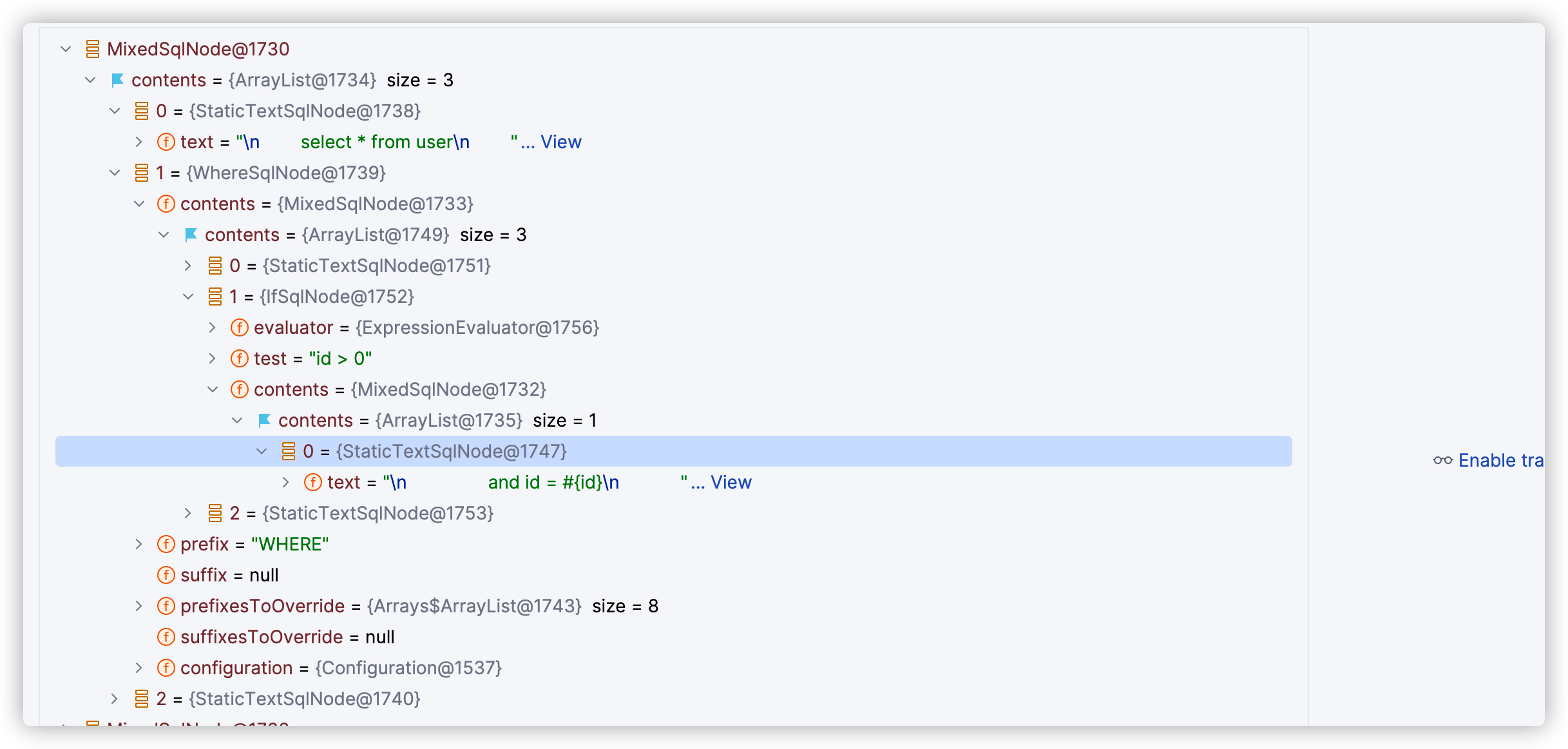


)
)











)



